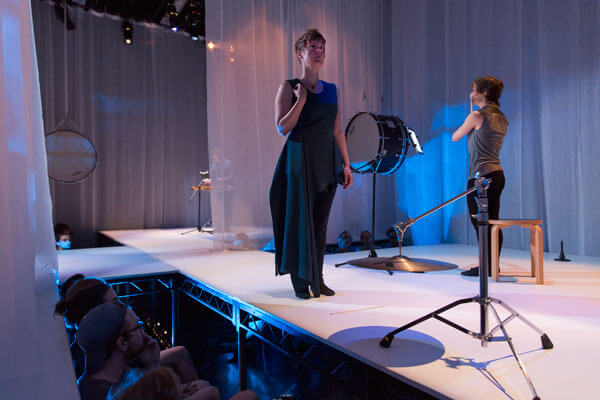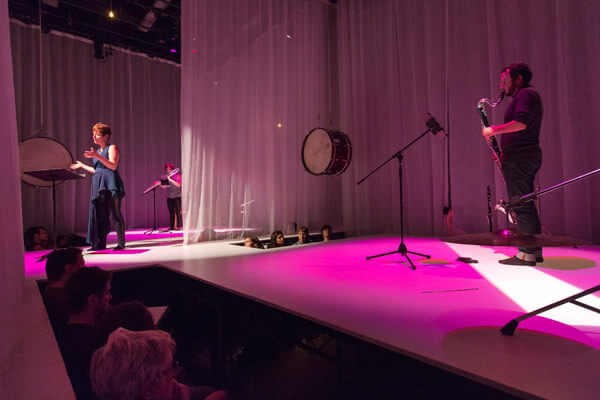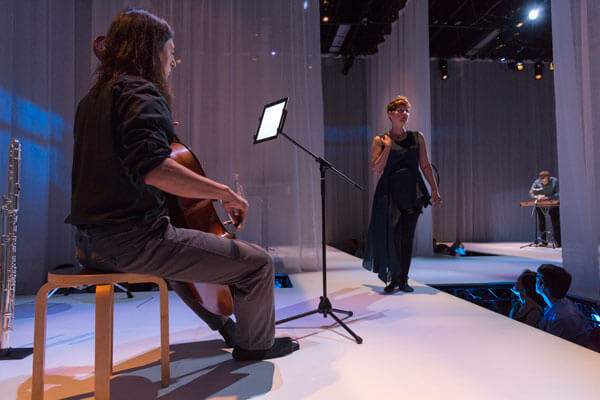 From internet memes, Korean knockoffs, and cloned stem cells to 3D printers, Elvis impersonators, and not, strictly speaking, legal downloads of your favorite television program, we live in a world of copies and duplicates. “Handcrafted,” “unrepeatable,” “one-of-a-kind”: these are utterly vestigial linguistic terms, for all you know they might as well have been Martian. Today, to imagine a perfectly singular, non-reproducible object is to think the very unthinkable. Yet this is precisely what David Lang has attempted in the whisper opera, his eagerly awaited new music-theater piece which received its New York premiere by the International Contemporary Ensemble (ICE) back on August 10, 2013 as part of Lincoln Center’s Mostly Mozart Festival.
From internet memes, Korean knockoffs, and cloned stem cells to 3D printers, Elvis impersonators, and not, strictly speaking, legal downloads of your favorite television program, we live in a world of copies and duplicates. “Handcrafted,” “unrepeatable,” “one-of-a-kind”: these are utterly vestigial linguistic terms, for all you know they might as well have been Martian. Today, to imagine a perfectly singular, non-reproducible object is to think the very unthinkable. Yet this is precisely what David Lang has attempted in the whisper opera, his eagerly awaited new music-theater piece which received its New York premiere by the International Contemporary Ensemble (ICE) back on August 10, 2013 as part of Lincoln Center’s Mostly Mozart Festival.

ICE members Tony Arnold and Claire Chase in the whisper opera at Mostly Mozart (photo credit: Richard Termine)
In a move that very nearly seems “conceptual” – so markedly does it fly in the face of one of our most deeply held musical assumptions du jour, that YouTube, Spotify, and all the various and sundry filesharing services are liberating cultural levelers – Lang has firmly stipulated that whisper can never be recorded, videotaped, or disseminated in any manner. So if you were hoping to see, say, a teaser trailer or maybe some libretto excerpts, well, think again. Implicit here is the conviction that mechanical reproduction has dulled music’s prodigious powers of enchantment, its unique mesmeric properties, though needless to say, whisper is as far from conceptual art as can be, for Lang’s aim is to bring about the sort of musical encounter that can only happen in person, via a real-time engagement between flesh-and-blood performers and an equally corporeal audience. In other words, you have to be there for it, and no amount of abstract summarizing could ever substitute for the genuine article. Sort of like life.
Let’s not get ahead of ourselves, though: Lang, who has long written for electric guitars, organs, and all manner of amplified instruments, is no luddite. Not only do whisper’s performers employ pedal-operated tablets, thereby eliminating page turn noises and obviating the need for stand lights, but Lang compiled the libretto from search engine hits: “I would write a sentence that was incomplete, and then I made a text by taking all the answers on the internet that completed it.” Call it crowdsourcing, if you will. Yet to the extent that whisper has a plot (it doesn’t) it can hardly be accused of being opportunistically topical. Our relationship with digital media is not the subject of the work per se, but rather can be said to comprise its very substance. Lang’s libretto-by-Google procedure was designed to dredge up various secrets and closeted truths, his thinking being that the internet’s inherent anonymity encourages people to cop to things they would never ever otherwise disclose. So there’s a real interplay at work here between the visible and the hidden, the audible and the muted. Unlike Nico Muhly’s Two Boys, however, whisper does not exploit this basic cyberspace truth as the au courant facade for an otherwise conventional theatrical conception. Instead, Lang has weaved the oscillation between what’s present and absent into the very fabric of the opera. Examples: the vocalist trades almost exclusively in muffled sentence fragments, your view of the action is constantly obstructed by ghostly scrims, the lighting and seating induce a sense of disorientation, and at all times, what you’re unable to hear is just as important as what you can hear.
Indeed, Lang has fashioned a score so quiet that no recording could ever do justice to its flickering, fleeting, evanescent course. So on first blush, the pervasive hush, this magical cocoon of reticence and introversion, seems but a pretext for a polemical statement on the virtues of live performance. But Lang is far too musical to ever let the concept outweigh the execution, and so by attuning us to a whole hidden universe of microscopic murmurs, contextual technological considerations quickly go by the wayside. Details you focus on instead: the delicate vapor of overtones released by cymbals struck with knitting needles; faint drum strokes and their unexpected echo effects; and the spectral interplay of multiple speaking voices. The clarinet plays only subtones, the cellist is muted for the duration, and the percussionist taps a glockenspiel with his fingertips. Lang’s restraint is astonishing, for not once does he use the odd unexpected sforzando (as in “Stick Figure” from Child) to remind you just how quiet things are. At first I wondered if this was a miscalculation: “How can you appreciate the silence when there’s nothing around to provide relief?” But Lang, you see, has simply been holding his trump card in reserve, for after an hour of meandering tintinnabulations and breathy susurrations, everything unexpectedly gels into what can only be described as a pop song. Instead of ppppp we’re now at pp, but it’s the most deafening pianissimo you’re apt to have ever heard. What’s more, for these brief few moments the vocalist is at long last allowed to use her singing voice. Thanks in part to Jim Findlay‘s hypnotic production, the stunning effect was akin to what a deaf person might feel, hearing miraculously restored after a lifetime of lonely silence.

ICE members Tony Arnold, Claire Chase, and Joshua Rubin perform the whisper opera (photo credit: Richard Termine)
The “opera” in the whisper opera should not be taken literally: this is a drama of gesture, of interactive instrumental actions. The musicians all double as actors, so it makes perfect sense that Lang should have written whisper for the International Contemporary Ensemble. Claire Chase and her musical partners-in-crime – here, Tony Arnold as the vocal protagonist alongside clarinetist Joshua Rubin, cellist Kivie Cahn-Lipman, and percussionist Ross Karre – positively revel in nontraditional challenges of just this sort. Indeed, ICE’s brio was beyond infectious, so I mean no disrespect when I also say that, paradoxically, their technical mastery actually worked against them. Walking in circles while carefully rubbing together two cowbells, or using a stage whisper for more than forty-five minutes straight, these aren’t easy tasks at ordinary decibel levels, let alone infinitesimal ones. From a performer’s standpoint, Lang clearly fashioned _whisper as one long sotto voce tightrope walk. Yet because the strain didn’t show, because ICE never once blinked, the “struggle” wasn’t always apparent for the audience.

Kivie Cahn-Lipman, Tony Arnold, and Ross Karre in David Lang’s the whisper opera (photo credit: Richard Termine)
Without seeing whisper a second time, I wouldn’t be able tell you if this was a flaw in Lang’s dramatic conception – but then, I daresay whisper was deliberately written so as to be impervious to multiple hearings. Parts of the score are so attenuated, it’s unlikely they would hold their interest more than once. Only 48 people are to be admitted to any given performance of whisper, and if this inadvertently lends the proceedings with a whiff of exclusivity, it also forces the recognition that you’ll likely die before you ever get the chance to hear the piece again. Consequently, you can’t help but attend to these passing measures with a preternatural intensity, trying to grasp each and every second like so many grains of sand inexorably falling through an hourglass. It’s an astonishingly, painfully beautiful experience, but for just this reason it’s not necessarily one you’d want to relive a second time around, even if you had the chance.




















